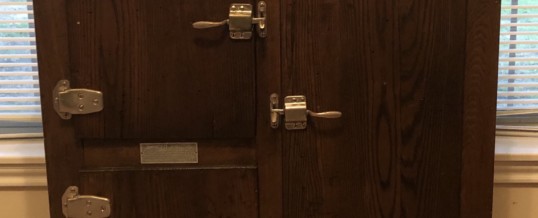
The fridge. Frigerator. Some even called it, “The Frigidaire.” A few decades ago it had many names.
Growing up, my family called it the “ice box,” even though it was an old term.
Today most of us refer to the kitchen appliance where we keep cold things as the refrigerator.
But an electrical appliance doesn’t work without electricity. And until the late 1940s, electricity wasn’t an option where my parents were raised. It just wasn’t available.
So, prior to having an electric refrigerator, you had few options for keeping food cold.
Most homesteads had a well. You could lower food by a rope into the well, but that was tedious and inconvenient.
A root cellar was a good option for long-term vegetable storage, but most dairy products required colder temps than the average root cellar provided.
The option most often used was to buy what was called an icebox.
Iceboxes were made from wood and had metal interiors and shelves to hold milk, cream, butter, or other foods that could spoil without refrigeration.
But most importantly, iceboxes have a large metal compartment to hold the item that gave the unit its name – ice. A large block of ice.
Each one had a pipe where the water from the melting ice could drain into a pan that was kept under the icebox behind a board that lifted up.
My mother’s father, Thomas Pickett, made his living delivering ice during the 1940s. He would drive to the ice plant to pick up different sizes of ice blocks and then deliver them to customers.
Ice blocks were sold by weight. Most homes had a nail in the front door where the owner would hang a square sign that indicated the size of ice they wanted.
The square sign had four different colors, with each color representing the ice block they needed. The one they wanted was indicated by the color placed at the top.
My grandfather would drive around with his oldest daughter (my Aunt Maxine) in tow to keep the books.
Often, the customers weren’t home, so he would let himself in, place the block in the icebox, and collect money that had been left for him or he would pick it up during the next visit.
Whichever customer’s house they delivered to around lunchtime was where they often were invited to eat.
Folks were like that back then. You didn’t have to lock your house, and if it was mealtime, you fed anyone who was in your home – whether they were there working or visiting.
As electricity made its way across the rural areas of the country, iceboxes went the way of the horse and buggy.
It was much easier to plug in that new Frigidaire and not worry with the ice, the drip pan or hanging a sign on the front door.
Consequently, the need for my grandfather’s services slowly diminished and then stopped.
After the war, he went to work for an ammunition plant. His days of ice deliveries were done.
Most folks didn’t keep their iceboxes. I’m guessing that many were disassembled and the wood was used for other things.
But a few survived. I have one of them.
My mother found it at a yard sale in my hometown many years ago. It had been painted and looked pretty rough. But she and my dad stripped it down to the wood and it now looks as it would have when my grandfather was delivering ice.
I have no idea whether the one I have ever lived in a home where my grandfather delivered ice, but I like to think that it did.
I can see him putting a block of ice in it and then sitting down as a guest to bless and then share a meal.
The world turned a little slower then. We took the time to visit, share and trust. That’s not something we can do much these days.
But I have an icebox to remind me that not so long ago, we could.
©2019 John Moore
John’s book, Write of Passage: A Southerner’s View of Then and Now, is available on Amazon and Barnes and Noble. You can reach John through his website at www.TheCountryWriter.com.
OCT
2019
